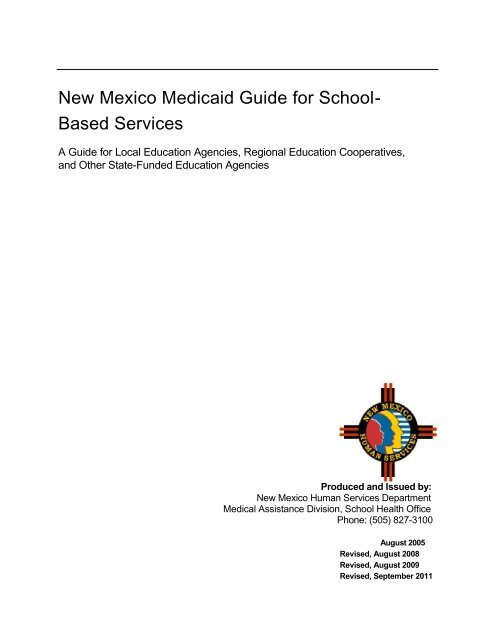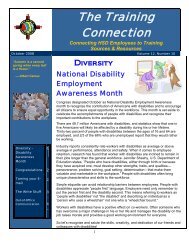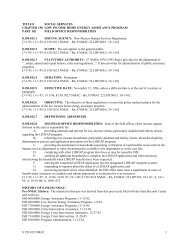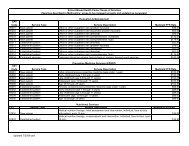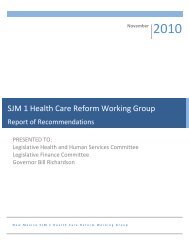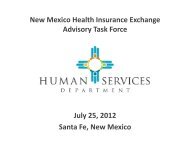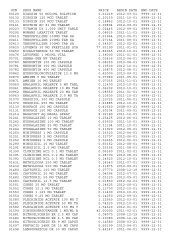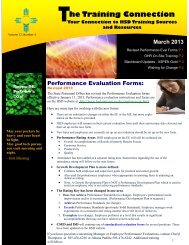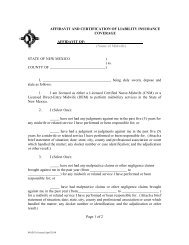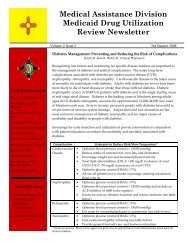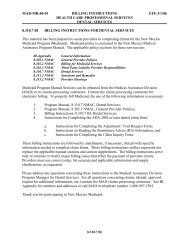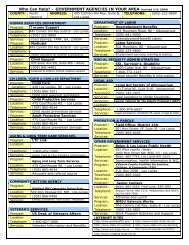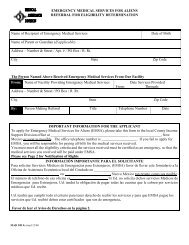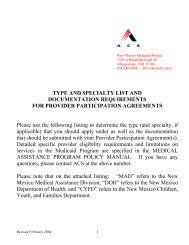New Mexico Medicaid Guide for School- Based Services
New Mexico Medicaid Guide for School- Based Services
New Mexico Medicaid Guide for School- Based Services
You also want an ePaper? Increase the reach of your titles
YUMPU automatically turns print PDFs into web optimized ePapers that Google loves.
<strong>New</strong> <strong>Mexico</strong> <strong>Medicaid</strong> <strong>Guide</strong> <strong>for</strong> <strong>School</strong>-<br />
<strong>Based</strong> <strong>Services</strong><br />
A <strong>Guide</strong> <strong>for</strong> Local Education Agencies, Regional Education Cooperatives,<br />
and Other State-Funded Education Agencies<br />
Produced and Issued by:<br />
<strong>New</strong> <strong>Mexico</strong> Human <strong>Services</strong> Department<br />
Medical Assistance Division, <strong>School</strong> Health Office<br />
Phone: (505) 827-3100<br />
August 2005<br />
Revised, August 2008<br />
Revised, August 2009<br />
Revised, September 2011
Table of Contents<br />
Section I: Program Introduction, History & Overview 3<br />
I. Introduction…… 3<br />
II. Background.….. 4<br />
III. <strong>School</strong>s as <strong>Medicaid</strong> Providers…… 5<br />
IV. Linkage Between <strong>School</strong>s & Health Care in their Communities... 5<br />
V. <strong>Medicaid</strong> <strong>Services</strong> <strong>for</strong> Children with Special Health Care Needs. 6<br />
VI. <strong>Medicaid</strong> Reimbursement to the <strong>School</strong> Districts…. 6<br />
VII. Purpose of the <strong>Guide</strong>…… 7<br />
Section II: Steps to Becoming a MSBS Provider………………. 8<br />
I.<br />
II.<br />
III.<br />
IV.<br />
V.<br />
VI.<br />
VII.<br />
VIII.<br />
Letter of Intent……<br />
Governmental <strong>Services</strong> Agreement ...…….<br />
Collaborative Plan……<br />
National Provider Identifier…….<br />
Provider Participation Agreement…….<br />
Compliance with State & Federal <strong>Guide</strong>lines….<br />
Identification of <strong>Medicaid</strong> Eligible Children….<br />
<strong>Medicaid</strong> Application Process & Presumptive Eligibility..<br />
Section III: Billing <strong>for</strong> Direct <strong>Services</strong>…………. 13<br />
I.<br />
II.<br />
III.<br />
IV.<br />
V.<br />
VI.<br />
VII.<br />
VIII.<br />
IX.<br />
Covered Direct <strong>Services</strong>……<br />
Non-Covered <strong>Services</strong>…..<br />
Individualized Treatment Plan.…<br />
Documentation Requirements….<br />
Provider Supervisory & Licensure Requirements…<br />
Coordination with Primary Care Providers…<br />
Claiming <strong>Medicaid</strong> Reimbursement <strong>for</strong> Direct <strong>Services</strong>..<br />
Remittance Advice & Resubmission of Claims….<br />
Provider Compliance…..<br />
Section IV: Billing <strong>for</strong> Administrative <strong>Services</strong>……. 20<br />
I.<br />
II.<br />
III.<br />
IV.<br />
V.<br />
VI.<br />
VII.<br />
VIII.<br />
IX.<br />
X.<br />
XI.<br />
XII.<br />
Administrative Claiming Time Study……<br />
Random Moment Sampling…..<br />
Time Study Participants.........<br />
Coding the Time Study…..<br />
Completing the Claim Form…..<br />
Offset of Revenues….<br />
Treatment of the Summer Period……<br />
Documentation of Administrative Activities……<br />
Administrative Claims Submission…..<br />
Monitoring, Oversight & Technical Assistance….<br />
Provider Compliance….<br />
Conclusion….<br />
8<br />
8<br />
9<br />
10<br />
10<br />
11<br />
12<br />
12<br />
13<br />
15<br />
15<br />
15<br />
16<br />
17<br />
18<br />
18<br />
19<br />
20<br />
20<br />
23<br />
23<br />
25<br />
25<br />
26<br />
26<br />
26<br />
27<br />
27<br />
28
Appendices<br />
Appendix A:<br />
Appendix B:<br />
Appendix C:<br />
Appendix D:<br />
Appendix E:<br />
Appendix F:<br />
Appendix G:<br />
Appendix H:<br />
Appendix I:<br />
Appendix J:<br />
Appendix K:<br />
Appendix L:<br />
Appendix M:<br />
Appendix N:<br />
Appendix O:<br />
Appendix P:<br />
Appendix Q:<br />
Appendix R:<br />
Appendix S:<br />
Governmental <strong>Services</strong> Agreement<br />
Provider Participation Agreements<br />
MSBS Program Regulations<br />
Covered <strong>Services</strong>, Procedure Codes & Rates<br />
<strong>Medicaid</strong> General Provider Policy<br />
MSBS Quality Assurance Checklist<br />
MSBS Provider Licensure & Supervision Requirements<br />
MSBS Procedure and Resources <strong>for</strong> Coordinating Care with a<br />
Recipient's Primary Care Provider<br />
Sampled Participant Email & RMTS Sample Participant Screens<br />
Administrative Claiming Activity Codes<br />
Job Codes & Descriptions <strong>for</strong> Time Study Employees<br />
NM MAC Program Participant List <strong>Guide</strong><br />
Administrative Claim Form and Cover Letter<br />
NM MAC Program Financial Reporting <strong>Guide</strong><br />
<strong>School</strong> Health Office & Managed Care Organization Contact<br />
In<strong>for</strong>mation<br />
Acronym Dictionary<br />
Annual Report<br />
<strong>Medicaid</strong> Site Visit Tool<br />
How to Spend MSBS Monies
<strong>New</strong> <strong>Mexico</strong> <strong>Medicaid</strong> <strong>Guide</strong> <strong>for</strong> <strong>School</strong>-<strong>Based</strong> <strong>Services</strong><br />
Section<br />
I<br />
Program Introduction, History &<br />
Overview<br />
I. Introduction<br />
Healthy children and youth have a better chance of achieving academic, social and personal success<br />
than children and youth who are singled-out by a health concern or disability that impacts their ability to<br />
participate in school. Because of their position in the daily lives of children, youth and their families,<br />
<strong>New</strong> <strong>Mexico</strong> schools are poised to offer unique advantages and opportunities that can help families<br />
access health in<strong>for</strong>mation, medical and behavioral health services, and facts about <strong>Medicaid</strong><br />
enrollment. Through the <strong>Medicaid</strong> <strong>School</strong>-<strong>Based</strong> <strong>Services</strong> (MSBS) program, <strong>New</strong> <strong>Mexico</strong> schools<br />
also offer key health and health-related services that are designed to integrate and maintain active<br />
learning <strong>for</strong> <strong>Medicaid</strong>-eligible children and youth with special education and health care needs.<br />
The MSBS program, <strong>for</strong>merly known as <strong>Medicaid</strong> in the <strong>School</strong>s (or MITS), was added in 1994 as a<br />
<strong>Medicaid</strong>-covered benefit <strong>for</strong> children and youth from age three through age 20. For a school to<br />
receive reimbursement <strong>for</strong> services through the MSBS program, each <strong>Medicaid</strong>-eligible recipient must<br />
receive an Individualized Education Plan (IEP) or Individualized Family Service Plan (IFSP) that<br />
specifies the services required to treat (through correction, amelioration, or the prevention of<br />
deterioration) his or her identified medical condition(s).<br />
The MSBS program vision, core beliefs and goals are:<br />
Vision<br />
All children and youth in <strong>New</strong> <strong>Mexico</strong> schools will be healthy and successful.<br />
Core Beliefs<br />
• Children and youth must be healthy in order to be successful in school. •<br />
<strong>School</strong>s are a critical link to children and youth's access to health care.<br />
• Comprehensive health focuses on the whole child and includes, but is not limited to,<br />
mental/behavioral, dental, physical, and vision health.<br />
• When comprehensive health services are readily and locally available at school, they can<br />
increase students' and families' access to needed care and result in improved student success.<br />
• Families are integral to the success of the MSBS program.<br />
• Public and private partnerships, collaboration and funding are necessary in order <strong>for</strong><br />
comprehensive health services to be available at or linked through schools.<br />
• Active participation of state agencies (the Human <strong>Services</strong> Department, Department of Health,<br />
Public Education Department, and Children, Youth and Families Department), families and the<br />
schools is essential <strong>for</strong> the MSBS program to function successfully.<br />
• Funds generated by the MSBS program will be used to support school health and healthrelated<br />
services <strong>for</strong> all children and youth.<br />
Program Goals<br />
1. To increase children and youth's access to comprehensive health services through the MSBS<br />
program.<br />
2. To increase and maximize the financial resources available <strong>for</strong> school-based services.<br />
3. To increase collaboration among schools, families, community providers, and state agencies,<br />
where each partner has a defined role and demonstrates commitment and accountability to the<br />
MSBS program.<br />
3
<strong>New</strong> <strong>Mexico</strong> <strong>Medicaid</strong> <strong>Guide</strong> <strong>for</strong> <strong>School</strong>-<strong>Based</strong> <strong>Services</strong><br />
4. To develop and implement standards <strong>for</strong> providing or linking through schools school-based<br />
comprehensive health services.<br />
5. To develop and implement a long-range plan <strong>for</strong> helping to ensure sustainability of a<br />
comprehensive MSBS program.<br />
6. To enroll students onto the <strong>Medicaid</strong> Program.<br />
Multiple resources were used in developing <strong>New</strong> <strong>Mexico</strong>'s MSBS program, including, but not limited to,<br />
the 42 CFR, Part 43, Center <strong>for</strong> Medicare and <strong>Medicaid</strong> <strong>Services</strong> (CMS) <strong>Medicaid</strong> <strong>School</strong>-<strong>Based</strong><br />
Administrative Claiming <strong>Guide</strong> of May 2003; the <strong>New</strong> <strong>Mexico</strong> State Plan; the regulation <strong>for</strong> <strong>New</strong><br />
<strong>Mexico</strong> <strong>Medicaid</strong> <strong>School</strong>-<strong>Based</strong> <strong>Services</strong> <strong>for</strong> Recipients Under 21 Years of Age at Section 8.320.6;<br />
in<strong>for</strong>mation from other states, including Iowa, Wisconsin, Florida, Michigan, Louisiana, Texas,<br />
Missouri, Washington, and Ohio; and the experiences of individuals who worked with the <strong>for</strong>mer MITS<br />
program in <strong>New</strong> <strong>Mexico</strong>. The <strong>New</strong> <strong>Mexico</strong> <strong>Medicaid</strong> <strong>Guide</strong> <strong>for</strong> <strong>School</strong>-<strong>Based</strong> <strong>Services</strong> (referred to<br />
hereafter as the <strong>Guide</strong>) represents the program that was developed in <strong>New</strong> <strong>Mexico</strong> with consideration<br />
given to these references and citations.<br />
II. Background<br />
Pursuant to the requirements of the Individuals with Disabilities Education Act (IDEA) and Section 504<br />
of the Rehabilitation Act of 1973, <strong>New</strong> <strong>Mexico</strong> schools deliver a broad range of educational, social<br />
and medical services that are needed to ensure a free and appropriate public education to children<br />
and youth who have disabilities. In <strong>New</strong> <strong>Mexico</strong>, the MSBS program includes a number of direct<br />
medical services, including: physical, occupational, audio logical, and speech therapies; mental health<br />
services; social services; nutritional assessments and counseling; transportation; case management;<br />
and nursing services. All of these services are reimbursable by <strong>Medicaid</strong> if they are determined to be<br />
medically necessary in accordance with <strong>Medicaid</strong> policy and are part of the<br />
<strong>Medicaid</strong>-eligible recipient's IEP or IFSP <strong>for</strong> the treatment of an identified medical condition.<br />
In addition to coverage of direct services, the MSBS program has historically allowed participating<br />
Local Education Agencies (LEAs), Regional Education Cooperatives (RECs) and other State-Funded<br />
Education Agencies (SFEAs) to claim reimbursement <strong>for</strong> certain allowable administrative activities;<br />
however, the Human <strong>Services</strong> Department Medical Assistance Division (HSD/MAD) discontinued the<br />
practice of administrative claiming on September 30, 2002. This generated momentum <strong>for</strong> a redesign<br />
of the MSBS program among both state agency and school district representatives, who determined<br />
that they would work together to resolve the key issues surrounding administrative claiming, including<br />
the codes, cost allocation methodology and time study model, and to reinstate an administrative<br />
claiming component of the MSBS program that would be effective, accurate and efficient.<br />
Administrative claiming was reinstated as part of the MSBS program on November 1, 2004.<br />
4
<strong>New</strong> <strong>Mexico</strong> <strong>Medicaid</strong> <strong>Guide</strong> <strong>for</strong> <strong>School</strong>-<strong>Based</strong> <strong>Services</strong><br />
III. <strong>School</strong>s as <strong>Medicaid</strong> Providers<br />
Federal <strong>Medicaid</strong> law does not mandate that schools be reimbursed <strong>for</strong> health and health-related<br />
services that are provided to <strong>Medicaid</strong>-eligible children; however, passage of the Medicare<br />
Catastrophic Coverage Act of 1988 (P.L. 100-360) clarified that federal <strong>Medicaid</strong> matching funds<br />
are available and may be used <strong>for</strong> health-related services that are covered under the <strong>Medicaid</strong><br />
State Plan when those services are provided under the auspices of IDEA as part of an IEP or IFSP,<br />
as under the MSBS program in <strong>New</strong> <strong>Mexico</strong>. Federal <strong>Medicaid</strong> reimbursement <strong>for</strong> health and<br />
health-related services provided to students receiving special education, and <strong>for</strong> outreach and care<br />
coordination activities provided to all students, may be generated by LEAs, RECs or SFEAs. These<br />
entities may draw down <strong>Medicaid</strong> reimbursement <strong>for</strong> the federal share of costs <strong>for</strong> health and<br />
health-related services that are provided to students who are <strong>Medicaid</strong> recipients.<br />
At the core of the MSBS program is the capacity of an LEA, REC or SFEA to secure the support of<br />
other agencies in the community. These supportive entities play a central role in the development of<br />
a collaborative plan designed to reinvest federal revenue generated through <strong>Medicaid</strong> into schoollinked<br />
and community-based services that target helping children, youth and their families. Federal<br />
<strong>Medicaid</strong> funding generated by the schools is returned, or "passed through", to the LEA, REC or<br />
SFEA by HSD/MAD. In turn, the schools are required to agree in advance to reinvest this funding<br />
into community services that are part of a broad collaborative plan. The details of this collaborative<br />
planning process are explained in a Governmental <strong>Services</strong> Agreement (GSA) entered into by the<br />
LEA, REC or SFEA and HSD/MAD. A template copy of the GSA can be found in the Appendix<br />
section of this <strong>Guide</strong> at Appendix A.<br />
IV. Linkage Between <strong>School</strong>s and Health Care in their Communities<br />
Another way in which MSBS-participating LEAs, RECs and SFEAs, as <strong>Medicaid</strong> providers, are<br />
required to interact with their communities is through the development of relationships with the<br />
health care resources in their communities at large, such as primary care providers (PCPs) and<br />
care coordinators <strong>for</strong> students enrolled in Salud! (<strong>New</strong> <strong>Mexico</strong>'s <strong>Medicaid</strong> managed care program),<br />
and Indian Health Service (IHS) providers <strong>for</strong> Native American students who are enrolled in fee-<strong>for</strong>service<br />
<strong>Medicaid</strong>. Because schools can play such a decisive role in the lives of children, youth and<br />
their families, they are able to link children and youth to health care and other services that might<br />
not otherwise be accessible. The MSBS program recognizes that most <strong>New</strong> <strong>Mexico</strong> communities<br />
have existing networks <strong>for</strong> ensuring health care to children and youth that include physicians and<br />
dentists in private practice, community health centers and maternal and child health programs, as<br />
well as the schools.<br />
Additionally, most of <strong>New</strong> <strong>Mexico</strong>'s <strong>Medicaid</strong>-enrolled children and youth receive benefits through<br />
one of the Salud! managed care organizations (MCOs) and the statewide entity (SE) <strong>for</strong> behavioral<br />
health services that have developed collaborative relationships with these community providers and<br />
programs. By working to develop relationships with the Salud! MCOs and health resources in their<br />
communities, the schools can help facilitate the connection between students and the services they<br />
need while improving the overall system of care available to children and youth, and reducing<br />
service duplication.<br />
5
<strong>New</strong> <strong>Mexico</strong> <strong>Medicaid</strong> <strong>Guide</strong> <strong>for</strong> <strong>School</strong>-<strong>Based</strong> <strong>Services</strong><br />
V. <strong>Medicaid</strong> <strong>Services</strong> <strong>for</strong> Children and Youth with Special Health Care<br />
Needs<br />
Each of the Salud! MCOs is contractually obligated to make visible ef<strong>for</strong>ts to identify and provide<br />
services to individuals who fall into a category called Children with Special Health Care Needs<br />
(CSHCN), who may also be eligible to receive treatment under the MSBS program. This requirement<br />
reflects both the strong commitment of HSD/MAD to increase access to care <strong>for</strong> children and youth in<br />
this particularly vulnerable population, and the significant need <strong>for</strong> progress in reaching their families.<br />
HSD/MAD recognizes that the schools provide a critical access point <strong>for</strong> the Salud! MCOs in<br />
achieving these goals, since many times the schools are the first point-of-contact <strong>for</strong> CSHCN<br />
children, youth and their families.<br />
Historically, <strong>New</strong> <strong>Mexico</strong> schools have been successful at providing multiple health and health-related<br />
services to their students. Since the passage of P.L. 94-142, schools have been required to provide<br />
certain health and health-related services to students who have both disabilities and special<br />
education needs. HSD/MAD believes that schools are favorably poised to assist all children and<br />
youth, including those who are <strong>Medicaid</strong>-eligible, in accessing the care they need. <strong>School</strong>s are<br />
involved not only in the early identification of health conditions, but also in the coordination of services<br />
with community resources and health care providers and in the provision of follow-up activities once a<br />
student has been referred <strong>for</strong> treatment.<br />
VI. <strong>Medicaid</strong> Reimbursements to the <strong>School</strong> Districts<br />
The cost of health-related services has traditionally been borne by LEAs, RECs and SFEAs through a<br />
mix of federal, state and local funding sources. However, under IDEA, federal law entitles children<br />
and youth with disabilities to a free and appropriate public education; there<strong>for</strong>e, schools cannot<br />
charge disabled students or their parents <strong>for</strong> any of the services that are provided under this<br />
mandate.<br />
Federal <strong>Medicaid</strong> funds may be reimbursed to LEAs, RECs and SFEAs <strong>for</strong> the MSBS program <strong>for</strong><br />
both direct services and administrative activities. The rates assigned to direct versus administrative<br />
claims are different, as are the billing and reimbursement processes <strong>for</strong> each.<br />
Direct <strong>Services</strong><br />
<strong>Medicaid</strong> direct services that are provided by professional personnel who meet qualifications set by<br />
HSD/MAD are reimbursable at adjusted and various rates, if there are state dollars available <strong>for</strong><br />
providing the services. The state's share is matched with federal dollars at an amount that is<br />
generally between 70 and 80 percent in <strong>New</strong> <strong>Mexico</strong>.<br />
Administrative <strong>Services</strong><br />
By contrast, administrative activities are reimbursable at a 50 percent matching rate with federal<br />
dollars. These activities include, but are not limited to: <strong>Medicaid</strong> outreach; facilitating <strong>Medicaid</strong><br />
eligibility determinations; translations related to <strong>Medicaid</strong> services; program planning, policy<br />
development and interagency coordination related to medical services; medical/<strong>Medicaid</strong> related<br />
training; referral, coordination and monitoring of <strong>Medicaid</strong> services; and scheduling referrals <strong>for</strong><br />
medical services. The amount that a school district may bill <strong>for</strong> administrative activities is based on a<br />
time-study model approved by HSD/MAD and CMS.<br />
6
<strong>New</strong> <strong>Mexico</strong> <strong>Medicaid</strong> <strong>Guide</strong> <strong>for</strong> <strong>School</strong>-<strong>Based</strong> <strong>Services</strong><br />
VII. Purpose of the <strong>Guide</strong><br />
This <strong>Guide</strong> is designed to provide MSBS program in<strong>for</strong>mation to <strong>New</strong> <strong>Mexico</strong>'s LEAs, RECs,<br />
SFEAs, state agencies, and other interested entities, concerning the correct and appropriate<br />
methods to follow in providing and seeking reimbursement <strong>for</strong> <strong>Medicaid</strong> school-based services,<br />
both direct and administrative, provided to students with IEPs and IFSPs. Additional in<strong>for</strong>mation<br />
about the <strong>Medicaid</strong> program and related eligibility and service policies is contained in the <strong>Medicaid</strong><br />
State Plan and the <strong>Medicaid</strong> Policy Manual. It is the obligation of each MSBS-participating LEA,<br />
REC and SFEA to ensure that they are in compliance with current <strong>Medicaid</strong> policy pertaining to the<br />
services they render. This <strong>Guide</strong> does not supersede <strong>Medicaid</strong> policy, and is not to be used in lieu<br />
of <strong>Medicaid</strong> policy. The in<strong>for</strong>mation contained in this <strong>Guide</strong> will be updated at least annually to<br />
reflect changes made to the MSBS program or overall <strong>Medicaid</strong> program.<br />
Specifically, this <strong>Guide</strong> is written to address key issues related to the MSBS program, namely:<br />
• To outline the steps required <strong>for</strong> schools and their ancillary personnel to become<br />
MSBS program providers;<br />
• To describe the direct services and administrative activities <strong>for</strong> which <strong>Medicaid</strong><br />
reimbursement may be claimed by LEAs, RECs and SFEAs;<br />
• To discuss the qualifications of the individuals providing <strong>Medicaid</strong>-reimbursable<br />
services in the schools;<br />
• To explain the procedures <strong>for</strong> claiming reimbursement <strong>for</strong> direct services and<br />
administrative activities; and<br />
• To summarize the programmatic expectations of LEAs, RECs and SFEAs that<br />
participate in the MSBS program<br />
7
<strong>New</strong> <strong>Mexico</strong> <strong>Medicaid</strong> <strong>Guide</strong> <strong>for</strong> <strong>School</strong>-<strong>Based</strong> <strong>Services</strong><br />
Section<br />
II<br />
Steps to Becoming a MSBS<br />
Provider<br />
There are five steps that a Local Education Agency (LEA), Regional Education Cooperative (REC) or<br />
other State-Funded Education Agency (SFEA) must take to become a <strong>Medicaid</strong> <strong>School</strong>-<strong>Based</strong><br />
<strong>Services</strong> (MSBS) program provider. These steps, which are outlined in detail in this <strong>Guide</strong>, include:<br />
submission of a letter of intent; entering into a Governmental <strong>Services</strong> Agreement (GSA) with the<br />
Human <strong>Services</strong> Department/Medical Assistance Division (HSD/MAD); establishing a collaborative<br />
plan; developing and submitting a <strong>Medicaid</strong> Outreach plan, and completing a provider participation<br />
application through the <strong>Medicaid</strong> fiscal agent, Affiliated Computer <strong>Services</strong> (ACS). Together, these<br />
actions ensure that an LEA, REC or SFEA and its providers are prepared to provide and bill <strong>for</strong><br />
services through the MSBS program, and that HSD/MAD and other state agencies are prepared to<br />
fulfill their obligations to school districts and to each other relating to the MSBS program.<br />
I. Letter of Intent<br />
The first step that an LEA, REC or SFEA must take in the process to become a MSBS program<br />
provider is to submit a letter of intent. This letter should be written to HSD/MAD and should be signed<br />
by the district superintendent, president of the school board, the chairperson of the LEA, REC or<br />
SFEA council, or other LEA, REC or SFEA representative. The letter should indicate the district's<br />
interest in working collaboratively with health and human services providers in the local community to<br />
develop services that will support children and their families, and in using <strong>Medicaid</strong> as a resource <strong>for</strong><br />
providing health and health-related services to children and youth through the MSBS program.<br />
The letter of intent should be mailed to:<br />
HSD/MAD <strong>School</strong> Health Office<br />
P.O. Box 2348<br />
Santa Fe, NM 87504-2348<br />
Once HSD/MAD has reviewed the letter, a packet of in<strong>for</strong>mation that includes a copy of this <strong>Guide</strong>,<br />
four original copies of the GSA, a <strong>Medicaid</strong> provider participation agreement, and a checklist <strong>for</strong> the<br />
Collaborative and <strong>Medicaid</strong> Outreach Plans will be sent to the LEA, REC or SFEA.<br />
II. Governmental <strong>Services</strong> Agreement<br />
For an LEA, REC or SFEA to become approved as a MSBS program provider, it must enter into a<br />
GSA with HSD/MAD. This agreement details the respective responsibilities of HSD and the LEA, REC<br />
or SFEA concerning program administration, billing and payment. It also explains program<br />
parameters such as confidentiality requirements and the dispute resolution process. A template copy<br />
of the GSA can be found in the Appendix section of this <strong>Guide</strong> at Appendix A.<br />
Once the individual with signatory authority at the LEA, REC or SFEA has signed and dated all four<br />
original copies of the GSA, all four original copies should be mailed to:<br />
HSD/MAD <strong>School</strong> Health Office<br />
P.O. Box 2348<br />
Santa Fe, NM 87504-2348<br />
8
<strong>New</strong> <strong>Mexico</strong> <strong>Medicaid</strong> <strong>Guide</strong> <strong>for</strong> <strong>School</strong>-<strong>Based</strong> <strong>Services</strong><br />
The original copies will then be <strong>for</strong>warded to the HSD Cabinet Secretary, Office of General Counsel,<br />
Administrative <strong>Services</strong> Division, and Department of Finance and Administration <strong>for</strong> final approval and<br />
signature. One original GSA, complete with signatures, will then be mailed back to the LEA, REC or<br />
SFEA <strong>for</strong> its records.<br />
III. Collaborative Plan / <strong>Medicaid</strong> Outreach Plan<br />
One of the most important steps that an LEA, REC or SFEA must take to become approved as a<br />
MSBS program provider is to develop a Collaborative and <strong>Medicaid</strong> Outreach plan that provides<br />
HSD/MAD with written evidence of the LEA's, REC's or SFEA's partnership with local community<br />
health and human services providers to deliver and expand health and health-related services. In<br />
summary, the Collaborative and <strong>Medicaid</strong> Outreach plan should be designed to identify community<br />
health needs and list strategies <strong>for</strong> meeting those needs. It must accompany the GSA as an<br />
attachment <strong>for</strong> the GSA to be considered <strong>for</strong> approval. Collaborative and <strong>Medicaid</strong> Outreach plans<br />
must be reviewed, amended as necessary, and submitted to HSD/MAD every two years.<br />
An effective collaborative plan should address a number of key components. These may include, but<br />
are not limited to:<br />
• Processes used and organizations and individuals involved in developing the plan.<br />
These entities may include, but are not limited to: local private and public medical,<br />
behavioral, social service, and oral/dental care providers; grass roots community<br />
leaders and organizations; community members or businesses; and teachers,<br />
parents and school support staff. It is expected that the ef<strong>for</strong>ts outlined in the<br />
collaborative plan will compliment any existing integrated planning ef<strong>for</strong>ts that are<br />
already underway in the community.<br />
• Processes used to assess community needs and establish priorities <strong>for</strong> the<br />
improvement and expansion of support services to all children and youth.<br />
• Common goals, both short-and long-range, <strong>for</strong> achieving improved outcomes <strong>for</strong><br />
children, youth and their families.<br />
• Procedures that will be used <strong>for</strong> fiscal and programmatic accountability purposes.<br />
Fiscal accountability is essential so that <strong>Medicaid</strong> revenues may be tracked<br />
accurately in accordance with the GSA and collaborative plan, while programmatic<br />
accountability should be expressed to facilitate specific measurable outcomes.<br />
• Possible barriers that might be presented during implementation of the plan and<br />
potential strategies <strong>for</strong> managing them.<br />
• Letters of agreement or support, and existing cooperative plans as supportive<br />
documentation.<br />
• Names of individuals or groups that will be responsible <strong>for</strong> achieving the identified<br />
outcomes, and strategies to determine whether the outcomes were met.<br />
A <strong>Medicaid</strong> outreach plan must include how the LEA, REC, or other SFEA will in<strong>for</strong>m, assess and<br />
enroll families seeking <strong>Medicaid</strong> coverage and must be a part of the Collaborative Plan. The <strong>Medicaid</strong><br />
Outreach Plan must specifically address the following:<br />
• Identify the individual(s) within or working with the LEA, REC, SFEA who will<br />
maintain<br />
active Presumptive Eligibility/<strong>Medicaid</strong> On-Site-Application-Assistance (PE/MOSAA)<br />
certification and per<strong>for</strong>m PE/MOSAA activities;<br />
• Establish a goal number of PE/MOSAA applications per year, based on the LEA's,<br />
REC's, SFEA's student population and health insurance demographics; and<br />
9
<strong>New</strong> <strong>Mexico</strong> <strong>Medicaid</strong> <strong>Guide</strong> <strong>for</strong> <strong>School</strong>-<strong>Based</strong> <strong>Services</strong><br />
• Describe the LEA's, REC's or other SFEA's commitment to reporting <strong>Medicaid</strong><br />
outreach and enrollment statistics to HSD quarterly, as set <strong>for</strong>th below.<br />
Report <strong>Medicaid</strong> outreach and enrollment statistics to HSD quarterly, including: the number of<br />
PE/MOSAA applications completed during the preceding quarter; the names and identifying<br />
in<strong>for</strong>mation of individuals <strong>for</strong> whom PE/MOSAA applications were completed during the preceding<br />
quarter; the dates that PE/MOSAA applications were sent to the HSD Income Support Division (ISD)<br />
during the preceding quarter; a listing of events and initiatives targeting families <strong>for</strong> <strong>Medicaid</strong><br />
enrollment held by the LEA, REC or other SFEA during the preceding quarter; and the number of<br />
family referrals to non-<strong>Medicaid</strong> public assistance programs made during the preceding quarter.<br />
HSD/MAD will work collaboratively with PED to review an LEA's, REC's or other SFEA's<br />
Collaborative and <strong>Medicaid</strong> Outreach plans, and to recommend approval <strong>for</strong> inclusion as a MSBS<br />
program provider.<br />
IV National Provider Identifier<br />
The National Provider Identifier (NPI) is a federally-mandated identification number issued to health<br />
care providers. All individual and organizational health care providers that are HIPAA-covered<br />
entities must obtain an NPI to identify themselves on billing transactions. MSBS related service<br />
providers, if previously required to have a <strong>Medicaid</strong> number, must now have an NPI in order to bill.<br />
Providers may apply <strong>for</strong> their own NPI or they may authorize the school district to obtain an NPI <strong>for</strong><br />
them. To learn more about the National Provider Identifier go to https://nppes.cms.hhs.gov<br />
V Provider Participation Agreement<br />
In addition to the signed GSA, collaborative plan, and <strong>Medicaid</strong> outreach plan, an LEA, REC or SFEA<br />
must submit a provider participation application to HSD/MAD. A template copy of the provider<br />
participation application <strong>for</strong>m and process can be found in the Appendix section of this <strong>Guide</strong> at<br />
Appendix B.<br />
Once the GSA has been signed, the completed provider participation application will be processed <strong>for</strong><br />
approval. Once approved, the LEA, REC or SFEA will receive a packet of in<strong>for</strong>mation, including a<br />
group provider number and billing resources from the HSD/MAD fiscal agent, Affiliated Computer<br />
Systems (ACS).<br />
As with all <strong>Medicaid</strong>-participating group providers such as clinics and hospitals, each rendering<br />
provider (the provider who actually delivers the service) must also be identified. To do this, a provider<br />
participation application should be completed by each of the district's following rendering providers:<br />
occupational and physical therapists, speech language pathologists, social workers, audiologists,<br />
speech-language pathology clinical fellows, and case managers. Rendering providers should submit<br />
their provider participation agreements with a copy of their certification(s) or license(s). The following<br />
provider types must submit a copy of both their board license and PED license: occupational and<br />
physical therapists, speech pathologists, speech-language pathology clinical fellows, licensed<br />
registered nurses, licensed practical nurses, licensed marriage & family therapists (LMFTs), licensed<br />
professional clinical counselors (LPCCs), licensed mental health counselors (LMHCs), licensed<br />
master's level independent social worker (LISWs), licensed master's level social worker (LMSWs),<br />
licensed bachelor's level social worker (LBSWs), and school psychologists.<br />
Some providers do not require a rendering provider number. These include: occupational and<br />
physical therapy assistants, speech-language pathology apprentices and paraprofessionals, licensed<br />
registered nurses, licensed practical nurses, licensed psychiatric clinical nurse specialists, licensed<br />
nutritionists, registered dieticians, and licensed bachelor's social workers. LEAs, RECs or SFEAs may<br />
10
<strong>New</strong> <strong>Mexico</strong> <strong>Medicaid</strong> <strong>Guide</strong> <strong>for</strong> <strong>School</strong>-<strong>Based</strong> <strong>Services</strong><br />
bill <strong>for</strong> services rendered by these providers using their LEA, REC or SFEA group provider number<br />
and/or the supervising provider's number.<br />
Initial applications must be submitted to the HSD/MAD <strong>School</strong> Health Office <strong>for</strong> an initial<br />
review. After the district has received approval and a group provider number, applications <strong>for</strong><br />
rendering providers may be processed.<br />
Many rendering providers may already have a <strong>Medicaid</strong> number (NPI). In these cases, the rendering<br />
provider must be affiliated with the LEA, REC or SFEA group provider number in order to bill <strong>for</strong><br />
services under that LEA, REC or SFEA. To become affiliated, the LEA, REC or SFEA must submit a<br />
letter, on its letterhead, to the <strong>Medicaid</strong> fiscal agent, ACS, requesting that the rendering provider be<br />
associated with the LEA, REC or SFEA. Copies of the provider's certifications and licenses should<br />
be included with the letter. The letter must be signed by both the rendering provider and an<br />
authorized representative of the LEA, REC or SFEA, and mailed or faxed to:<br />
ACS, Inc.<br />
Attn: Provider Enrollment<br />
1720-A Randolph Rd, SE<br />
Albuquerque, NM 87106<br />
FAX: (505) 246-9085<br />
Each rendering provider will receive his or her own provider <strong>Medicaid</strong> number and (NPI).This<br />
<strong>Medicaid</strong> number and (NPI) will be used by the LEA, REC or SFEA to bill <strong>Medicaid</strong> <strong>for</strong> services<br />
provided only by that individual or <strong>for</strong> services rendered by a provider that they supervise. The LEA,<br />
REC or SFEA should bill <strong>Medicaid</strong> using its group provider number (NPI) with a reference to the<br />
rendering provider. As individual rendering providers change, each new rendering provider must<br />
submit an application and receive a rendering provider number (NPI). It is the responsibility of the<br />
LEA, REC or SFEA to identify rendering providers who have left employment with the district and are<br />
no longer authorized to provide services. A letter of disaffiliation should be sent to ACS at the<br />
address listed above.<br />
Once the LEA, REC or SFEA becomes a MSBS program provider, it must notify ACS in writing of any<br />
changes in its provider status. These might include changes in contact in<strong>for</strong>mation, the area in which<br />
services are being provided, or taxpayer identification numbers. The LEA's, REC's or SFEA's group<br />
provider number should always be included in any written correspondence. Notice of changes should<br />
be sent to ACS at the address listed above.<br />
Rendering providers must have a current <strong>New</strong> <strong>Mexico</strong> Regulation and Licensing Department (RLD) or<br />
other valid state license on file at ACS to maintain an active <strong>Medicaid</strong> enrollment status. The new<br />
license must be submitted to ACS within 90 days of the expiration date of the last license. The<br />
license should be sent to ACS at the address listed above or faxed to ACS/Provider Enrollment at<br />
(505) 246-9085. Failure to submit the license will result in termination of the provider's <strong>Medicaid</strong><br />
number.<br />
A re-verification document <strong>for</strong> each enrolled provider must be completed and returned to ACS every<br />
two years. ACS will send the document to be completed and signed by the provider. Failure to<br />
submit the re-verification document will result in termination of the provider's <strong>Medicaid</strong> number.<br />
VI. Compliance with State and Federal <strong>Guide</strong>lines<br />
HSD/MAD is firmly committed to administering a MSBS program that is effective in the lives of<br />
recipients, is "user-friendly" to participating schools and their providers, and is compliant with both<br />
state and federal law. Together with HSD/MAD and <strong>New</strong> <strong>Mexico</strong>'s LEAs, RECs and SFEAs, there are<br />
a number of entities that have key responsibilities to the MSBS program and who play a critical role in<br />
effecting positive outcomes <strong>for</strong> school-age children and youth. The regulations <strong>for</strong> <strong>New</strong><br />
11
<strong>New</strong> <strong>Mexico</strong> <strong>Medicaid</strong> <strong>Guide</strong> <strong>for</strong> <strong>School</strong>-<strong>Based</strong> <strong>Services</strong><br />
<strong>Mexico</strong>'s MSBS program (MAD 8.320.6) may be found in the Appendix section to this <strong>Guide</strong> at<br />
Appendix C.<br />
The federal Centers <strong>for</strong> Medicare and <strong>Medicaid</strong> <strong>Services</strong> (CMS) are charged with dispensing federal<br />
<strong>Medicaid</strong> funds to HSD/MAD <strong>for</strong> the provision of services to <strong>Medicaid</strong>-eligible populations and the<br />
administration of <strong>Medicaid</strong> programs at the state level. In turn, to ensure federal funding, HSD/MAD<br />
must abide by CMS' guidelines and regulations concerning the flow of program dollars, reporting<br />
deadlines, quality, and service delivery. For the MSBS program, these guidelines preclude<br />
reimbursement <strong>for</strong> the costs of <strong>Medicaid</strong>-covered services and activities that are generally available to<br />
all students without expense and <strong>for</strong> which no other sources of reimbursement are pursued. For<br />
example, <strong>Medicaid</strong> cannot pay <strong>for</strong> routine school-based vision and hearing screens or <strong>for</strong> other<br />
primary and preventive services that are given to all students on a cost-free basis.<br />
VII. Identification of <strong>Medicaid</strong> Eligible Children<br />
Each MSBS-participating LEA, REC or SFEA is expected to validate the recipient's <strong>Medicaid</strong> eligibility<br />
prior to billing. Because a recipient's eligibility may not be continuous from month to month, it is<br />
critical that the LEA, REC or SFEA, as a provider of services, be able to document that the recipient<br />
was <strong>Medicaid</strong>-eligible during the time <strong>for</strong> which the claim was submitted.<br />
To inquire about a recipient's eligibility, enrolled providers may contact the ACS Automated Voice<br />
Response System (AVRS) at 1-800-820-6901 24 hours a day/7days a week. To ensure<br />
confidentiality, the provider will need to provide AVRS with the LEA, REC or SFEA group provider<br />
number and the recipient's name, date of birth and social security or <strong>Medicaid</strong> identification number.<br />
Providers are encouraged to use ACS' Web Portal to inquire about a recipient's eligibility. Log on to<br />
http://nmmedicaid.acs-inc.com/ <strong>for</strong> more in<strong>for</strong>mation and to register as a Web Portal user.<br />
VIII. <strong>Medicaid</strong> Application Process and Presumptive Eligibility<br />
For a child less than 18 years old to receive <strong>Medicaid</strong>, a family member or legal guardian must apply<br />
<strong>for</strong> benefits on their behalf, unless the child is legally emancipated or has qualifying extenuating<br />
circumstances. Applications are processed at local offices of the HSD Income Support Division<br />
(ISD). To find out the location of the nearest HSD/ISD office, the LEA, REC or SFEA may contact<br />
HSD at 1-888-997-2583 or visit the HSD web site at: http://www.hsd.state.nm.us/isd/fieldoffices.html<br />
Because the approval process is not immediate, many LEAs, RECs or SFEAs may have Presumptive<br />
Eligibility (PE) workers who are certified to receive <strong>Medicaid</strong> applications and make temporary<br />
coverage determinations on site (also called <strong>Medicaid</strong> On-Site Application Assistance or MOSAA).<br />
These applications are then <strong>for</strong>warded to HSD/ISD <strong>for</strong> official eligibility determination; however, in the<br />
meantime, individuals who are presumed to be eligible may receive <strong>Medicaid</strong> services until the last<br />
day of the following month. PE/MOSAA determinations can be done every six months. <strong>School</strong><br />
districts who wish to receive training <strong>for</strong> their employees to become PE/MOSAA determiners should<br />
call Robyn Reede, PE/MOSAA Trainer, at (505)476-6802, or send her an e-mail at<br />
robyn.reede@state.nm.us.<br />
The LEA, REC, SFEA will document PE/MOSAA ef<strong>for</strong>ts in their quarterly <strong>Medicaid</strong> Outreach-<br />
Enrollment Site Summary Report and in the <strong>Medicaid</strong> Outreach Plan.<br />
12
<strong>New</strong> <strong>Mexico</strong> <strong>Medicaid</strong> <strong>Guide</strong> <strong>for</strong> <strong>School</strong>-<strong>Based</strong> <strong>Services</strong><br />
Section<br />
III Billing <strong>for</strong> Direct <strong>Services</strong><br />
I. Covered Direct <strong>Services</strong><br />
In accordance with <strong>Medicaid</strong> <strong>School</strong>-<strong>Based</strong> <strong>Services</strong> (MSBS) program regulations at 8.320.6.13<br />
(which can be found in the Appendix section to this <strong>Guide</strong> at Appendix C), a Local Education Agency<br />
(LEA), Regional Education Cooperative (REC) or other State-Funded Education Agency (SFEA) that is<br />
approved as a <strong>Medicaid</strong> provider may be reimbursed <strong>for</strong> certain health services provided to <strong>Medicaid</strong><br />
recipients. These services must meet several conditions to be eligible <strong>for</strong> payment through<br />
the MSBS program, including:<br />
• The services provided must be medically necessary and coordinated with the recipient's<br />
primary care provider (PCP);<br />
• The services must be necessary to the treatment of the recipient's specific identified<br />
medical condition and meet the needs specified in the Individualized Education Plan<br />
(IEP) or Individualized Family Service Plan (IFSP).<br />
• The services listed on the Individualized Treatment Plan (ITP) section of the IEP or IFSP<br />
must be signed by the child's PCP and be developed together with a team of qualified<br />
physical therapists, occupational therapists, speech therapists, audiologists, nurses,<br />
and/or behavioral health providers;<br />
• The frequency and duration of services billed to <strong>Medicaid</strong> may not exceed what is<br />
specified in the IEP or IFSP; and<br />
• Parental Consent must be obtained <strong>for</strong> services listed in the IEP or IFSP in order to bill<br />
<strong>for</strong> <strong>Medicaid</strong>. Consent means that the parent has been fully in<strong>for</strong>med of all in<strong>for</strong>mation<br />
relevant to the activity <strong>for</strong> which consent is sought. The parent understands and agrees in<br />
writing. CFR300.0 (Code of Federal Regulations) as does NMAC6.31.2.9 (<strong>New</strong> <strong>Mexico</strong><br />
Administrative code) requires parental consent. For more in<strong>for</strong>mation about IDEA<br />
requirements, contact the Special Education Bureau of the <strong>New</strong> <strong>Mexico</strong> Public Education<br />
Department (PED) at (505) 827-6541.<br />
Reimbursement is made directly to the LEA, REC or SFEA, even when therapy providers offer<br />
services under contract to the LEA, REC or SFEA.<br />
Under the MSBS program, direct services include:<br />
• Initial evaluations that result in an IEP and subsequent re-evaluations.<br />
• Therapies, including: Physical, occupational and audio logical therapies and speech<br />
language pathology required <strong>for</strong> treatment of an identified medical condition.<br />
• Mental health services, including: counseling, evaluation and therapy required <strong>for</strong><br />
treatment of an identified medical condition. These services include regularly scheduled<br />
and structured counseling or therapy sessions <strong>for</strong> recipients, either independently, with<br />
their parents or guardians, or with other family groups. Mental health services may be<br />
furnished by:<br />
• A licensed independent social worker (LISW);<br />
• A licensed marriage and family therapist (LMFT);<br />
• A licensed professional clinical counselor (LPCC);<br />
• A psychiatric clinical nurse specialist (CNS);<br />
• A psychiatrist, psychologist or psychologist associate; or<br />
13
<strong>New</strong> <strong>Mexico</strong> <strong>Medicaid</strong> <strong>Guide</strong> <strong>for</strong> <strong>School</strong>-<strong>Based</strong> <strong>Services</strong><br />
• A licensed bachelor's level social worker, (LBSW) licensed master's level social<br />
worker, (LMSW) or licensed mental health counselor (LMHC) supervised by a<br />
Ph.D., Psy.D., Ed.D., or LISW.<br />
• Nutritional assessments and counseling that are provided by a licensed nutritionist or<br />
dietician <strong>for</strong> a recipient who has been referred <strong>for</strong> a nutritional need. A nutritional<br />
assessment consists of an evaluation of the nutritional needs of individuals based on<br />
appropriate biochemical, anthropomorphic, physical, and dietary data, including a<br />
recommendation <strong>for</strong> appropriate nutritional intake.<br />
• Transportation services <strong>for</strong> recipients who must travel from the school to receive a<br />
covered service from a <strong>Medicaid</strong> provider because the service is unavailable in the<br />
school setting. Transportation services are reimbursable when provided on the date of a<br />
scheduled medical service. They are also reimbursable <strong>for</strong> transporting disabled<br />
students to and from the school on the date of a scheduled service if the recipient<br />
requires transportation in a modified vehicle that meets the recipient's needs.<br />
• Case management services that are furnished in the school setting to recipients who<br />
are considered to be "medically at-risk", a term that refers to individuals who have a<br />
diagnosed physical or mental health condition with a high probability of impairing their<br />
cognitive, emotional, neurological, social or physical development. Case management<br />
services must be coordinated with the recipient's managed care organization (MCO) if the<br />
recipient is enrolled in the Salud! program. Examples of case management activities<br />
that are covered under the MSBS program include:<br />
• Assessments of the recipient's medical, social and functional abilities every<br />
six months, unless more frequent reassessment is indicated by the<br />
recipient's condition;<br />
• Developing and implementing a comprehensive plan of care that helps the<br />
recipient retain or achieve a maximum degree of independence;<br />
• Mobilizing "natural helping" networks, such as family members, church<br />
members, community organizations, support groups, friends and the school;<br />
and<br />
• Coordinating and monitoring the delivery of services, evaluating the<br />
effectiveness and quality of services, and revising the plan of care as<br />
necessary.<br />
Recipients have the freedom to choose a case management service provider. <strong>Medicaid</strong><br />
pays <strong>for</strong> only one case management provider to furnish services during a given time<br />
period. If a recipient has a case manager or chooses a case manager who is not<br />
employed or under contract with the LEA, REC, or SFEA, the LEA, REC, SFEA must<br />
coordinate with the case manager in the development of the Individualized Treatment<br />
Plan (ITP).<br />
• Nursing services that are required to treat an identified medical condition that qualifies a<br />
recipient <strong>for</strong> an IEP or IFSP. Nursing services require professional nursing expertise and<br />
must be provided by a licensed registered nurse (RN) or licensed practical nurse (LPN) in<br />
accordance with the <strong>New</strong> <strong>Mexico</strong> Nurse Practice Act. Emergency nursing services are<br />
also covered, when they are referenced in the IEP or IFSP and relate to the recipient's<br />
identified medical condition.<br />
The procedure codes <strong>for</strong> MSBS-covered direct services and their <strong>Medicaid</strong><br />
reimbursement rates may be found in the Appendix section of this <strong>Guide</strong> at Appendix D.<br />
14
<strong>New</strong> <strong>Mexico</strong> <strong>Medicaid</strong> <strong>Guide</strong> <strong>for</strong> <strong>School</strong>-<strong>Based</strong> <strong>Services</strong><br />
II. Non-Covered <strong>Services</strong><br />
The services that are provided in the school setting under the MSBS program are subject to certain<br />
limitations and restrictions, similar to those set <strong>for</strong> other <strong>Medicaid</strong> services. Specifically, these<br />
include:<br />
• <strong>Services</strong> that are classified as educational;<br />
• <strong>Services</strong> to non-<strong>Medicaid</strong> eligible individuals;<br />
• <strong>Services</strong> provided by practitioners outside their area of expertise;<br />
• Vocational training services that are related exclusively to specific employment<br />
opportunities, work skills or work settings;<br />
• <strong>Services</strong> that duplicate those furnished outside of the school setting, unless<br />
determined to be medically necessary and given prior authorization by the Human<br />
<strong>Services</strong> Department/Medical Assistance Division or its designee;<br />
• Transportation services that a recipient would otherwise receive in the course of<br />
attending school; and<br />
• Transportation services <strong>for</strong> a recipient with special education needs under the<br />
Individuals with Disabilities Education Act (IDEA) who rides the regular school bus to<br />
and from school with other non-disabled children.<br />
III. Individualized Treatment Plan<br />
The ITP is the medical portion of an IEP or IFSP and should be designed to state the medical needs,<br />
objectives, duration, service, and provider type of any reimbursable medical treatment to be provided<br />
under the MSBS program. The ITP is developed pursuant to the recipient's health history, medical<br />
and educational evaluations, and recommendations of his or her PCP, if applicable. The ITP should<br />
be developed by the LEA, REC or SFEA, together with recipients, their families, and the appropriate<br />
service providers. It is a plan of care that should be agreed upon by the recipient's parents or legal<br />
guardians, evaluating therapists, IEP or IFSP committee, and teacher. The recipient's PCP must<br />
review and sign the ITP at least annually.<br />
IV. Documentation Requirements<br />
To ensure compliance with state and federal regulations, the LEA, REC or SFEA should maintain<br />
adequate records to document service delivery <strong>for</strong> six years from the date of service. At a<br />
minimum, records documenting the provision of one of the services covered by the MSBS program<br />
should include:<br />
• The name of the LEA, REC or SFEA;<br />
• The recipient's name, date of birth and <strong>Medicaid</strong> number/unique identifier; •<br />
The date and location of the service;<br />
• The procedure code <strong>for</strong> the service;<br />
• A description of the service provided, including the diagnosis code and level of<br />
service;<br />
• Signatures and credentials of the rendering provider(s) (when the rendering provider<br />
works under the supervision of another provider, the supervisor must also initial the<br />
document); and<br />
• The document showing involvement of the student's PCP or documentation of the<br />
LEA's, REC's or SFEA's good faith attempt to obtain a response from the PCP in<br />
accordance with Section III, Part VI of this <strong>Guide</strong>.<br />
15
<strong>New</strong> <strong>Mexico</strong> <strong>Medicaid</strong> <strong>Guide</strong> <strong>for</strong> <strong>School</strong>-<strong>Based</strong> <strong>Services</strong><br />
Documentation should support the medical necessity of the service in accordance with the <strong>Medicaid</strong><br />
regulation <strong>for</strong> medically necessary services found in the <strong>Medicaid</strong> General Provider Policy at MAD<br />
8.302.1.7, which may be found in the Appendix section of this <strong>Guide</strong> at Appendix E.<br />
A quality assurance checklist was developed by the HSD/MAD <strong>School</strong> Health Office to assist schools<br />
in ensuring that they meet all of the required documentation standards <strong>for</strong> the MSBS program. This<br />
tool may be found in the Appendix section to this <strong>Guide</strong> at Appendix F.<br />
V. Provider Licensure and Supervisory Requirements<br />
To participate in the MSBS program and receive reimbursement, an LEA, REC or SFEA must be<br />
enrolled as a participating <strong>Medicaid</strong> provider. Individual service providers that are employed by or are<br />
under contract with the LEA, REC or SFEA must be authorized to enter into separate <strong>Medicaid</strong><br />
provider participation agreements by meeting licensing and other qualification criteria. The steps that<br />
must be taken by the LEA, REC or SFEA and by individual providers are specified in detail in Section<br />
II, Part IV of this <strong>Guide</strong>.<br />
Eligible direct service providers and their qualifications include:<br />
• Physical therapists and physical therapy assistants who are licensed by the Physical<br />
Therapy Board under the <strong>New</strong> <strong>Mexico</strong> Regulation and Licensing Department (RLD) and<br />
who meet licensure requirements of the Public Education Department (PED). Physical<br />
therapy assistants must work under the supervision of a licensed physical therapist.<br />
• Occupational therapists and occupational therapy assistants who are licensed by<br />
the Occupational Therapy Board under RLD and who meet licensure requirements of<br />
PED. Occupational therapy assistants must work under the supervision of a licensed<br />
occupational therapist.<br />
• Speech pathologists, audiologists and speech language pathology apprentices<br />
who are licensed by the Board of Speech-Language Pathology and Audiology under RLD<br />
and who meet licensure requirements of PED. Speech language pathology apprentices<br />
must work under the supervision of a licensed speech pathologist.<br />
• Social work practitioners who are:<br />
Licensed by the Social Work Examiners Board as master's level independent<br />
social work practitioners; or<br />
Licensed by the Social Work Examiners Board and supervised by a licensed<br />
Ph.D., Psy.D, Ed.D or LISW.<br />
Social work practitioners must meet licensure requirements of PED.<br />
• Psychologists who are:<br />
• Psychologists (Ph.D., Psy.D. or Ed.D.) licensed by the <strong>New</strong> <strong>Mexico</strong> Psychologist<br />
Examiners Board; or<br />
• Master's level practitioners licensed by the <strong>New</strong> <strong>Mexico</strong> Psychologist Examiners<br />
Board as psychologist associates or licensed by PED as school psychologists<br />
and supervised by a psychiatrist or Ph.D., Psy.D. or Ed.D. who is licensed by the<br />
<strong>New</strong> <strong>Mexico</strong> Psychologist Examiners Board<br />
• Psychologists must meet licensure requirements of PED. Level One <strong>School</strong><br />
Psychologists must be supervised by a Ph.D., Psy. D. or Ed. D. Levels Two<br />
and Three <strong>School</strong> Psychologists do not require supervision.<br />
• Physicians and psychiatrists who are licensed by the Board of Medical Examiners.<br />
16
<strong>New</strong> <strong>Mexico</strong> <strong>Medicaid</strong> <strong>Guide</strong> <strong>for</strong> <strong>School</strong>-<strong>Based</strong> <strong>Services</strong><br />
• Case managers who:<br />
o Have a bachelor's degree in social work, counseling, psychology, nursing, or a<br />
related health or social services field from an accredited institution, and who have<br />
one year of experience in serving medically at-risk children or youth;<br />
o Have a registered or practical nurse license; or<br />
o Have a bachelor's degree in another field, but who have two years of direct<br />
experience in serving medically at-risk children or adolescents.<br />
o Case managers must be registered as Case Managers with ACS.<br />
• Licensed professional clinical counselors who are licensed by the <strong>New</strong> <strong>Mexico</strong><br />
Counseling and Therapy Practice Board under RLD and who meet licensure<br />
requirements of PED.<br />
• Licensed marriage and family therapists who are licensed by the <strong>New</strong> <strong>Mexico</strong><br />
Counseling and Therapy Practice Board under RLD.<br />
• Licensed psychiatric clinical nurse specialists who are licensed by the <strong>New</strong> <strong>Mexico</strong><br />
Board of Nursing.<br />
• Licensed nutritionists or registered dieticians who are licensed by the <strong>New</strong> <strong>Mexico</strong><br />
Nutrition and Dietetics Practice Board and who meet licensure requirements of PED.<br />
• Licensed registered and practical nurses who are licensed by the <strong>New</strong> <strong>Mexico</strong> Board<br />
of Nursing and who meet licensure requirements of PED.<br />
• Licensed mental health counselors who are licensed by the <strong>New</strong> <strong>Mexico</strong> Counseling<br />
and Therapy Practice Board under RLD and are supervised by a Phd.D., Psy.D., or Ed.<br />
D.<br />
A document outlining, who may participate in the MSBS program as a direct service provider, and<br />
their licensure and supervision requirements, may be found in the Appendix section of this <strong>Guide</strong> at<br />
Appendix G.<br />
Contact in<strong>for</strong>mation <strong>for</strong> RLD may be found at www.rld.state.nm.us.The PED Licensure Unit may be<br />
reached at (505) 827-6587.<br />
VI. Coordination with Primary Care Providers<br />
In <strong>New</strong> <strong>Mexico</strong>, most of the children and youth who are enrolled in <strong>Medicaid</strong> receive physical health<br />
benefits through one of four Salud! managed care organizations (MCOs) and have a designated<br />
physician or nurse practitioner that is called their PCP. The role of the PCP is to provide a "medical<br />
home" <strong>for</strong> the recipient, to maintain the recipient's medical records, and to make referrals or authorize<br />
treatment that may be required as the result of diagnostic or routine screening visits, such as the Totto-Teen<br />
Healthcheck.<br />
PCP participation is critical to the overall success of the MSBS program. PCPs are asked to review<br />
and sign at least annually the ITP portion of a recipient's IEP or IFSP. In some school districts,<br />
particularly those in larger urban areas or in areas with busy PCP practices, ensuring PCP<br />
involvement has posed a challenge. A school district may make a "good faith" ef<strong>for</strong>t to obtain the<br />
review and signature of a student's PCP by following and documenting certain steps. These steps are<br />
outlined in the <strong>Medicaid</strong> <strong>School</strong>-<strong>Based</strong> <strong>Services</strong> Procedure <strong>for</strong> Involving a Student's Primary Care<br />
Provider, which can be found in the Appendix section to this <strong>Guide</strong> at Appendix H.<br />
17
<strong>New</strong> <strong>Mexico</strong> <strong>Medicaid</strong> <strong>Guide</strong> <strong>for</strong> <strong>School</strong>-<strong>Based</strong> <strong>Services</strong><br />
VII. Claiming <strong>Medicaid</strong> Reimbursement <strong>for</strong> Direct <strong>Services</strong><br />
For an LEA, REC or SFEA to receive reimbursement <strong>for</strong> the IEP direct services and therapies<br />
described in Section III, Part I of this <strong>Guide</strong>, it must meet several criteria. In summary, the LEA, REC<br />
or SFEA must:<br />
• Be an approved and enrolled <strong>Medicaid</strong> provider (refer to Section II of this <strong>Guide</strong>);<br />
• File claims <strong>for</strong> reimbursement to the <strong>Medicaid</strong> fiscal agent, Affiliated Computer<br />
<strong>Services</strong> (ACS), within 120 days of the date that the service was provided; and<br />
• Submit electronic claims <strong>for</strong> reimbursement on the 837P Health Care Encounter<br />
<strong>for</strong>m.<br />
Direct service billing <strong>for</strong>ms may be purchased at any office or <strong>for</strong>ms supply location. Web-based<br />
electronic billing is available at no cost to providers through the <strong>New</strong> <strong>Mexico</strong> <strong>Medicaid</strong> program.<br />
Training and technical assistance in how to bill <strong>for</strong> direct services is available to all MSBSparticipating<br />
LEAs, RECs or SFEAs from ACS. ACS provider services staff may be reached at 1-<br />
800-299-7304, ext 190.<br />
An LEA, REC or SFEA should bill <strong>for</strong> the direct services that are provided by staff who meet the<br />
professional requirements listed in Section III, Part V of this <strong>Guide</strong>. For example, an LEA, REC or<br />
SFEA would be responsible <strong>for</strong> submitting speech therapy claims provided by speech therapists in<br />
accordance with the child's IEP, when that child is <strong>Medicaid</strong>-eligible.<br />
To receive reimbursement <strong>for</strong> services, an LEA, REC or SFEA should have well-developed <strong>Medicaid</strong><br />
claim procedures in place. The documentation requirements discussed in Section III, Part IV of this<br />
<strong>Guide</strong> are designed to prepare districts <strong>for</strong> a potential onsite audit by HSD/MAD, the Centers <strong>for</strong><br />
Medicare and <strong>Medicaid</strong> <strong>Services</strong> (CMS), or the U.S. Department of Health and Human <strong>Services</strong><br />
Office of Inspector General, and to ensure that billing is done only <strong>for</strong> enrolled staff. In contrast to<br />
many other <strong>Medicaid</strong> programs, services provided under the MSBS program do not require prior<br />
approval once the service is specified in the recipient's IEP or IFSP and coordinated with the<br />
recipient's PCP.<br />
VIII. Remittance Advice and Resubmission of Claims<br />
To ensure payment on a claim, all of the required fields on the CMS 1500 <strong>for</strong>m (08/05 version) if<br />
billing on paper, or the 837P Health Care Encounter <strong>for</strong>m if billing electronically, must be complete<br />
and accurate. If the <strong>for</strong>m is incomplete or incorrectly completed, the claim may be denied <strong>for</strong><br />
payment. If an LEA, REC or SFEA receives a remittance advice showing that the claim was denied,<br />
the same claim may be corrected and resubmitted to the <strong>Medicaid</strong> fiscal agent, ACS.<br />
Resubmission of denied claims must be submitted within 180 days of the denial date on the<br />
remittance advice. A copy of the remittance advice page showing the denial must be attached to the<br />
claim as proof of timely filing. If filing electronically, corrected claims may be resubmitted<br />
electronically within the original 120-day time period without proof of timely filing. Requests <strong>for</strong><br />
adjustments on paid claims must be submitted to ACS using the Adjustment/Void Request <strong>for</strong>m.<br />
Specific instructions can be obtained from the fiscal agent by contacting ACS provider services at 1-<br />
800-299-7304.<br />
Once a claim has been approved and processed <strong>for</strong> payment, a remittance advice that shows the<br />
status of all claims that the district has submitted to ACS will be available online at<br />
http://nmmedicaid.acs-inc.com Remittance advices are critical <strong>for</strong> tracking correctable errors <strong>for</strong><br />
resubmitted denied claims. A remittance advice newsletter containing important billing in<strong>for</strong>mation is<br />
available online every Monday. LEAs, RECs and SFEAs should review the remittance advice<br />
newsletter regularly to keep up-to-date on any changes regarding MSBS direct service billing<br />
processes. Questions about remittance advices may be directed to ACS provider services.<br />
18
<strong>New</strong> <strong>Mexico</strong> <strong>Medicaid</strong> <strong>Guide</strong> <strong>for</strong> <strong>School</strong>-<strong>Based</strong> <strong>Services</strong><br />
X. Provider Compliance<br />
The documentation requirements Section III, Part IV, and the other program requirements listed<br />
throughout Section III, are designed to ensure that participating LEAs, RECs and SFEAs comply with<br />
all MSBS program guidelines, policies and regulations <strong>for</strong> direct health services. Each MSBS site will<br />
be reviewed once every four years <strong>for</strong> program compliance or as needed.<br />
• The LEA, REC or SFEA will be required to submit a Corrective Action Plan (CAP) to<br />
HSD/MAD within 30 working days of the date of receipt of the site review letter to remedy<br />
the immediate noncompliance issue(s);<br />
The LEA, REC or SFEA may be referred to the Medical Assistance Division Quality Assurance<br />
Bureau <strong>for</strong> a prospective and/or retrospective audit. The following may occur after an audit by the<br />
<strong>Medicaid</strong> Quality Assurance Bureau:<br />
• If indicated, funds owed may be recouped from the LEA, REC or SFEA;<br />
• In all cases, the LEA, REC or SFEA has the option to appeal through HSD/MAD's<br />
administrative hearing process pursuant to the <strong>Medicaid</strong> provider hearing regulations;<br />
and<br />
• If indicated, the LEA, REC or SFEA may be terminated from participation in the MSBS<br />
program, as set <strong>for</strong>th in <strong>Medicaid</strong> General Provider Policies, 8.302.1<br />
(refer to Appendix E).<br />
19
<strong>New</strong> <strong>Mexico</strong> <strong>Medicaid</strong> <strong>Guide</strong> <strong>for</strong> <strong>School</strong>-<strong>Based</strong> <strong>Services</strong><br />
Section<br />
IV<br />
Billing <strong>for</strong> Administrative <strong>Services</strong><br />
In addition to reimbursing Local Education Agencies (LEAs), Regional Education Cooperatives<br />
(RECs) and State-Funded Education Agencies (SFEAs) <strong>for</strong> direct health services that are part of a<br />
child's Individualized Education Plan (IEP) or Individualized Family Service Plan (IFSP), the <strong>Medicaid</strong><br />
<strong>School</strong>-<strong>Based</strong> <strong>Services</strong> (MSBS) program also reimburses LEAs, RECs and SFEAs <strong>for</strong> the costs of<br />
certain administrative activities that directly support ef<strong>for</strong>ts to provide health-related services to<br />
<strong>Medicaid</strong>-eligible children and youth with special education and health care needs. These<br />
administrative activities include, but are not limited to: providing in<strong>for</strong>mation about <strong>Medicaid</strong> programs<br />
and how to access them; facilitating the eligibility determination process; assisting recipients in<br />
obtaining transportation and translation services when necessary to receive health care services;<br />
making referrals <strong>for</strong> <strong>Medicaid</strong>-reimbursable services; and coordinating and monitoring medical<br />
services that are covered by <strong>Medicaid</strong>. These and other activities that may be reimbursed under the<br />
MSBS program are described in detail in this Section of the <strong>Guide</strong>.<br />
The Administrative Claim is based on the LEA's, REC's or SFEA's <strong>Medicaid</strong> eligibility rate, which is<br />
figured by the following:<br />
• LEA, REC, or SFEA submit their 40-day count to the <strong>Medicaid</strong> <strong>School</strong>s Health Office<br />
annually. The 40-day count plus any confidential student in<strong>for</strong>mation must be submitted<br />
through the MOVE IT DMZ portal, which is the MAD secure email system.<br />
• The <strong>School</strong> Health Office matches the 40-day count through the <strong>Medicaid</strong> data warehouse<br />
• The percentage of <strong>Medicaid</strong> eligible recipients will be used on the LEA's REC's or SFEA's<br />
claim.<br />
I. Administrative Claiming Time Study………………………………………….<br />
A LEA, REC, and SFEA must participate in Direct Service billing in order to be eligible to participate in<br />
Administrative Claiming. To participate in the MSBS administrative claiming program, a LEA, REC or<br />
SFEA must require certain district staff to participate in a quarterly time study that covers the period<br />
<strong>for</strong> which claimed administrative activities were per<strong>for</strong>med. This time study, in turn, provides the basis<br />
<strong>for</strong> calculating amounts owed to the districts <strong>for</strong> these activities.<br />
While many school district staff participate in administrative activities that are eligible <strong>for</strong><br />
reimbursement by <strong>Medicaid</strong>, most do so only <strong>for</strong> a portion of their normal workday and at varying<br />
intervals. The time study allows MSBS program staff to determine this proportion. Components of<br />
the administrative claiming time study include:<br />
• Administering a random moment sampling (RMTS) methodology;<br />
• Participating in the time study;<br />
• Coding the time study; and<br />
• Completing the claim <strong>for</strong>m.<br />
II. Random Moment Sampling………………………………………………………<br />
The RMTS time study model is used to measure the percentage of time that LEA, REC and SFEA staff<br />
spends in per<strong>for</strong>mance of <strong>Medicaid</strong>-reimbursable administrative activities by sampling and assessing<br />
the activities of a randomly selected cross-section of individuals. These individuals are queried at<br />
random over a billing quarter about their activities during a specified moment on a certain date. The<br />
results of these queries are then tallied and averaged <strong>for</strong> the quarter. These averages, taken<br />
20
<strong>New</strong> <strong>Mexico</strong> <strong>Guide</strong> <strong>for</strong> <strong>School</strong>-<strong>Based</strong> <strong>Services</strong><br />
together with the LEA's REC's or SFEA's allocation of costs and <strong>Medicaid</strong> eligibility rate, determine the<br />
amount that the LEA, REC or SFEA is eligible to receive <strong>for</strong> administrative activities during the sampled<br />
quarter. The sampling period is defined as the same three-month period comprising each<br />
quarter of the calendar:<br />
• First Quarter: January 1-March 31<br />
• Second Quarter: April 1-June 30<br />
• Third Quarter: July 1-September 30<br />
• Fourth Quarter: October 1-December 31<br />
The HSD/MAD <strong>School</strong> Health Office along with Fairbanks administer <strong>New</strong> <strong>Mexico</strong>'s RMTS system. In<br />
summary, the RMTS system works as follows:<br />
• Forty-five days prior to the beginning of each quarter, participating LEAs, RECs or<br />
SFEAs submit a staff roster (Participant List) providing a comprehensive list of staff<br />
eligible to participate in the RMS time study. The list of names is subsequently grouped<br />
into job categories (that describe their job function), and from that list all job categories<br />
are assigned into one of two “cost pools” as previously defined. Once the roster of<br />
eligible staff is submitted it cannot be updated or changed once the RMS period begins.<br />
The NM MAC program Participant List <strong>Guide</strong> may be found at Appendix L of this <strong>Guide</strong>.<br />
• The total pool of “moments” within the time study is represented by the calculating the<br />
number of working days in the sample period, times the number of work hours of each<br />
day, times the number of minutes per hour, and times the number of participants within<br />
the time study. The total pool of moments <strong>for</strong> the quarter is reduced by the exclusion of<br />
weekends, holidays and hours during which employees are not scheduled to work.<br />
• Once compiled statewide, each cost pool is sampled to identify participants in the RMS<br />
time study. The sample is selected from each statewide cost pool, along with the total<br />
number of eligible time study moments <strong>for</strong> the quarter. Using a statistically valid random<br />
sampling technique, the desired number of random moments is selected from the total<br />
pool of moments. Next, each randomly selected moment is matched up using a<br />
statistically valid random sampling technique, with an individual from the total pool of<br />
participants.<br />
• Each time the selection of a moment and the selection of a name occurs, both the minute<br />
and the name are returned to the overall sample pool to be available <strong>for</strong> selection again.<br />
In other words, the random selection process is done with replacement so that each<br />
moment and each person are available to be selected each time a selection occurs. This<br />
step guarantees the randomness of the selection process.<br />
• Each selected moment is defined as a specific one-minute unit of a specific day from the<br />
total pool of time study moments and is assigned to a specific time study participant.<br />
Each moment selected from the pool is included in the time study and coded according to<br />
the documentation submitted by the employee.<br />
21
<strong>New</strong> <strong>Mexico</strong> <strong>Guide</strong> <strong>for</strong> <strong>School</strong>-<strong>Based</strong> <strong>Services</strong><br />
Time study participants are notified via email to participate in the time study and of their sampled<br />
moment. Sampled participants will be notified of their sampled moment no earlier than three<br />
days prior to their sampled moment. At the prescribed moment, each sampled participant is asked<br />
to record and submit his/her activity <strong>for</strong> that particular moment. The sampled moment will remain<br />
open <strong>for</strong> 7 calendar days after the specific moment has occurred. The participant will receive<br />
reminders 3 business days be<strong>for</strong>e and then 2, 3, 4 and 5 business days after the sampled<br />
moment has occurred. After the 7 th calendar day the participant’s login will not work.<br />
<br />
<br />
<br />
<br />
<br />
<br />
Fairbank’s Central Coders will review the documentation of participant activities<br />
per<strong>for</strong>med during the selected moments and determine the appropriate activity code. In a<br />
situation when insufficient in<strong>for</strong>mation is provided to determine the appropriate activity<br />
code, the central coder will contact the sampled participant and request submission of<br />
additional in<strong>for</strong>mation about the moment. In addition, the Program Coordinator at the<br />
applicable LEA, REC or SFED is copied on that follow-up email so that they are aware<br />
that a request <strong>for</strong> additional in<strong>for</strong>mation has been made. Once the in<strong>for</strong>mation is received<br />
the moment will be coded and included in the final time study percentage calculation. All<br />
moments will be coded separately by at least two coders as part of a quality assurance<br />
process. The moments and the assigned codes will be reviewed <strong>for</strong> consistency and<br />
adherence to the state approved activity codes. Administrative Activity Time Study<br />
Codes may be found at Appendix J of this <strong>Guide</strong>.<br />
Moments not returned by the school district will not be included in the database unless<br />
the return rate <strong>for</strong> valid moments is less than 85%. If the state wide return rate of valid<br />
moments is less than 85%, all non-returned moments will be included and coded as non-<br />
<strong>Medicaid</strong>. To assure that districts are properly returning sample moments, districts’<br />
return percentages <strong>for</strong> each quarter will be analyzed. If an individual district has nonreturns<br />
greater than 15%, HSD may take appropriate action using sanctions, which may<br />
include but not be limited to conducting more frequent monitoring reviews, eliminating the<br />
school district’s claimed portion of federal funds, or ultimately, termination of the school<br />
district’s Governmental <strong>Services</strong> Agreement.<br />
HSD\MAD will per<strong>for</strong>m the following validity checks to ensure that all districts complete at<br />
least 85% of valid random moment samples. HSD\MAD will also review 5% of valid<br />
coded responses and coding on a quarterly basis.<br />
At the end of each quarter, once all Random Moment data has been received and Time<br />
Study results have been calculated, statistical compliance reports will be generated to<br />
serve as documentation that the sample results have met the necessary statistical<br />
requirements.<br />
The cost allocation methodology and financial data used <strong>for</strong> the MSBS administrative<br />
claiming program are consistent with the requirements of OMB Circular A-87 and<br />
generally accepted accounting standards.<br />
Participating LEAs will submit quarterly claims to HSD. These claims will be based on the<br />
quarterly costs, time study results, the <strong>Medicaid</strong> eligibility rate, the provider participation<br />
rate, and the FFP.<br />
22
<strong>New</strong> <strong>Mexico</strong> <strong>Medicaid</strong> <strong>Guide</strong> <strong>for</strong> <strong>School</strong>-<strong>Based</strong> <strong>Services</strong><br />
III. Time Study Participants………………………………………………………………..<br />
When an LEA, REC or SFEA constructs the list of staff that should be included in the time study, it<br />
must determine first whether the individuals in those positions per<strong>for</strong>m administrative activities that<br />
support the MSBS program, and second whether they are less than 100 percent federally funded.<br />
All LEA, REC or SFEA employees involved in administrative activities are assigned to one of two<br />
previously defined cost pools. Financial expenditures related to this staff are reported on a<br />
quarterly basis by the LEA, REC or SFEA. Costs are broken down as follows:<br />
Cost Pool 1: Direct Service Staff<br />
Staff in Cost Pool 1 are Direct Service staff that have direct responsibilities related to the MSBS<br />
program that include the regular per<strong>for</strong>mance of one or more <strong>Medicaid</strong> allowable administrative<br />
activities.<br />
Cost Pool 2: Other Health and Health-Related Staff<br />
Staff in Cost Pool 2 include other health and health-related staff involved in direct administrative<br />
activities.<br />
For a complete list of positions that may be included in the time study, refer to the Appendix section<br />
to this <strong>Guide</strong> at Appendix K.<br />
Employees and contracted staff who may participate in the time study generally include, but are not<br />
limited to:<br />
• Providers of direct health services;<br />
• <strong>School</strong> health aides; and<br />
• Program and staffing specialists.<br />
Certain individuals should not participate in the time study. In general, these include:<br />
• Principals;<br />
• Coaches;<br />
• Non-special education teachers;<br />
• Transportation staff;<br />
• Janitorial staff;<br />
• Cafeteria workers:<br />
100% federally funded staff<br />
IV. Coding the Time Study…………………………………………………………………...<br />
There are 17 administrative activity codes that may be used to complete the time study. These are:<br />
CODE 1A Non-<strong>Medicaid</strong> Outreach – U<br />
CODE 1B <strong>Medicaid</strong> Outreach – TM/50 Percent FFP<br />
CODE 2A Facilitating Application <strong>for</strong> Non-<strong>Medicaid</strong> Programs – U<br />
CODE 2B Facilitating Application <strong>for</strong> <strong>Medicaid</strong> Programs – TM/50 Percent FFP<br />
CODE 3 <strong>School</strong>-Related and Education Activities – U<br />
CODE 4A Direct Medical <strong>Services</strong>, Not Covered as IDEA/IEP Service – U<br />
23
<strong>New</strong> <strong>Mexico</strong> <strong>Medicaid</strong> <strong>Guide</strong> <strong>for</strong> <strong>School</strong>-<strong>Based</strong> <strong>Services</strong><br />
CODE 4B Direct Medical <strong>Services</strong>, Covered as IDEA/IEP Service - U<br />
CODE 5A Transportation <strong>for</strong> Non-<strong>Medicaid</strong> Programs – U<br />
CODE 5B Transportation <strong>for</strong> <strong>Medicaid</strong> Programs – PM/50 Percent FFP<br />
CODE 6A Non-<strong>Medicaid</strong> Translation – U<br />
CODE 6B Translation Related to <strong>Medicaid</strong> <strong>Services</strong> – PM/75 Percent FFP<br />
CODE 7A Program Planning, Policy Development and Interagency Coordination Related to<br />
Non-Medical <strong>Services</strong> – U<br />
CODE 7B Program Planning, Policy Development and Interagency Coordination Related to <strong>Medicaid</strong><br />
<strong>Services</strong> – PM/50 Percent FFP<br />
CODE 8A Non-Medical/Non-<strong>Medicaid</strong> Training – U<br />
CODE 8B Medical/<strong>Medicaid</strong> Related Training – PM/50 Percent FFP<br />
CODE 9A Referral, Coordination and Monitoring of Non-<strong>Medicaid</strong> <strong>Services</strong> – U<br />
CODE 9B Referral, Coordination and Monitoring of Medical <strong>Services</strong> – PM/50 Percent FFP<br />
CODE 10 General Administration – R<br />
CODE 11 Not Paid/Not Worked – U<br />
In accordance with federal rules, the time study must incorporate a comprehensive list of the activities<br />
per<strong>for</strong>med by staff whose costs are to be claimed under <strong>Medicaid</strong>. That is, the time study must reflect<br />
all of the time and activities, whether allowable or unallowable by <strong>Medicaid</strong>, per<strong>for</strong>med by employees<br />
participating in the MSBS administrative claiming program. There<strong>for</strong>e, <strong>for</strong> each reimbursable<br />
administrative activity code, there is a corresponding non-reimbursable activity code.<br />
Each of the allowable time study codes may be reimbursed under the MSBS administrative claiming<br />
program at the 50 percent federal financial participation (FFP) rate. Unallowable activities are<br />
disallowed as administration under the <strong>Medicaid</strong> program, regardless of whether the population<br />
served includes <strong>Medicaid</strong>-eligible individuals.<br />
There are two codes (1B and 2B) that are 100 percent allowable as administration under the<br />
<strong>Medicaid</strong> program. Reimbursement <strong>for</strong> the remaining allowable codes is determined based on the<br />
application of the proportional <strong>Medicaid</strong> population in the LEA, REC or SFEA, also known as the<br />
<strong>Medicaid</strong> eligibility rate. For these codes, the <strong>Medicaid</strong> share is determined as the ratio of <strong>Medicaid</strong><br />
eligible students to total students.<br />
General administrative activities per<strong>for</strong>med by time study participants must be reallocated across the<br />
other activity codes on a pro rata basis. These reallocated activities are reported under the General<br />
Administration code (GA).<br />
A detailed description of the MSBS administrative activity codes can be found in the Appendix section of<br />
this <strong>Guide</strong> at Appendix J.<br />
24
<strong>New</strong> <strong>Mexico</strong> <strong>Medicaid</strong> <strong>Guide</strong> <strong>for</strong> <strong>School</strong>-<strong>Based</strong> <strong>Services</strong><br />
V. Completing the Claim Form…………………..........................................................<br />
The claim <strong>for</strong>m, which can be found in the Appendix section of this <strong>Guide</strong> at Appendix M, includes<br />
several components. In summary, these include:<br />
• General data regarding the LEA's, REC's or SFEA's direct and indirect quarterly<br />
costs;<br />
• Data regarding the LEA's, REC's or SFEA's capital allocation, including buildings and<br />
equipment;<br />
• The time study percentages, which are based on the RMS time study results <strong>for</strong> the<br />
quarter;<br />
• The LEA's, REC's or SFEA's percentage of <strong>Medicaid</strong>-eligible recipients(MER) ;<br />
• Data regarding the LEA's, REC's or SFEA's quarterly salary and benefit costs;<br />
• The administrative claim invoice, which considers the factors listed above; and<br />
• The quarterly certification of state expenditures, which is signed by the LEA, REC or<br />
SFEA.<br />
Detailed instructions regarding completion of the claim <strong>for</strong>m can be found in the Appendix section to<br />
this <strong>Guide</strong> at Appendix N.<br />
The claim <strong>for</strong>m is due to the HSD/MAD <strong>School</strong> Health Office no later than 45 days after the end of<br />
the billing quarter. Time frames may be reduced further due to state fiscal year-end closing dates.<br />
Each LEA, REC or SFEA should identify the person who will be responsible <strong>for</strong> completing the claim<br />
<strong>for</strong>m and provide their contact in<strong>for</strong>mation to the HSD/MAD <strong>School</strong> Health Office.<br />
VI. Offset of Revenues…………………………………………………………………...<br />
Certain revenues must offset allocation costs to reduce the total amount of costs in which the federal<br />
government will participate. To the extent that the funding sources have paid or would pay <strong>for</strong> the<br />
costs at issue, federal <strong>Medicaid</strong> funding is not available and the costs must be removed from total<br />
costs. The following include some of the revenue offset categories that must be applied in developing<br />
the LEA's, REC's or SFEA's net costs:<br />
• All federal funds;<br />
• All state expenditures that have been previously matched by the federal government;<br />
• Insurance and other fees collected from non-governmental sources;<br />
• All applicable credits (those receipts or reduction-of-expenditure type transactions that<br />
offset or reduce expense items allocable to federal awards as direct or indirect costs); and<br />
Expenditures by which the total cost has already been paid by any of the revenue<br />
sources above. A government program may not be reimbursed in excess of its actual<br />
costs.<br />
25
<strong>New</strong> <strong>Mexico</strong> <strong>Medicaid</strong> <strong>Guide</strong> <strong>for</strong> <strong>School</strong>-<strong>Based</strong> <strong>Services</strong><br />
VII. Treatment of the Summer Period,,,,,,,,,,,,,,,,,,,,,,,,,,,,,,,,,,,,,,,,,,,,,,,,,,,,,,,,,,,,,,,,,,,,,,,,,,<br />
The summer period is distinguished from the regular school year, and refers to the period between<br />
the end of one regular school year and the beginning of the next regular school year. In general, a<br />
time study is developed and conducted with respect to a particular period, and must represent and<br />
incorporate the actual activities per<strong>for</strong>med during that period.<br />
The HSD/MAD <strong>School</strong> Health Office verifies the last day of the school year <strong>for</strong> each LEA, REC, or<br />
SFEA, and enters those dates to determine the final day of sampling <strong>for</strong> the quarter. RMTS activities<br />
<strong>for</strong> the following school year will begin on the first day of school <strong>for</strong> each LEA, REC or SFEA.<br />
VIII. Documentation of Administrative Activities*****************************************<br />
All LEAs, RECs or SFEAs that submit administrative claims must maintain separate files of all<br />
documentation used to construct claims <strong>for</strong> each quarter billed. Required documents include:<br />
• The accounting in<strong>for</strong>mation upon which the claim <strong>for</strong>m is based, including the basis <strong>for</strong><br />
any inclusion or exclusion of costs;<br />
• A list of all revenues that were offset when calculating the claim;<br />
• The enrollment lists used to determine the <strong>Medicaid</strong> eligibility rate;<br />
• Time study documentation, including the sample pool participants by function, title, name,<br />
identification number, location, telephone number and code assigned to their activity;<br />
• The completed quarterly claim;<br />
• A copy of the warrant;<br />
• Job descriptions of employees included in the sample pool;<br />
• Proof of employee attendance <strong>for</strong> individuals included in the sample pool; and<br />
• Any other supporting in<strong>for</strong>mation used to substantiate the claim.<br />
LEAs, RECs or SFEAs must ensure that these files are current, complete, accessible and secure.<br />
Administrative claim files must be maintained <strong>for</strong> a minimum of six years.<br />
A quality assurance checklist was developed by the <strong>Medicaid</strong> <strong>School</strong> Health Office to assist schools<br />
in ensuring that they meet all of the required documentation standards <strong>for</strong> the MSBS program. The<br />
quality assurance checklist may be found in the Appendix section to this <strong>Guide</strong> at Appendix F.<br />
IX. Administrative Claims Submission***************************************************<br />
MSBS-participating LEAs, RECs and SFEAs are responsible <strong>for</strong> submitting administrative claims in<br />
accordance with these guidelines:<br />
• All staff involved in the preparation and certification of administrative claims, including the<br />
LEA's, REC's or SFEA's third-party billing agent(s), if applicable, must attend HSD/MADsponsored<br />
training sessions concerning MSBS and provider regulations, policies and<br />
procedures, the provision of <strong>Medicaid</strong>-reimbursable services and the preparation and<br />
submission of claims.<br />
• All administrative claims must be prepared and submitted on <strong>for</strong>ms developed and<br />
approved by HSD/MAD, in accordance with federal and state <strong>Medicaid</strong> regulations,<br />
policies and guidelines, the CMS <strong>Medicaid</strong> <strong>School</strong>-<strong>Based</strong> Administrative Claiming <strong>Guide</strong><br />
of May 2003, this <strong>Guide</strong>, and any federal or state revisions hereto.<br />
26
<strong>New</strong> <strong>Mexico</strong> <strong>Medicaid</strong> <strong>Guide</strong> <strong>for</strong> <strong>School</strong>-<strong>Based</strong> <strong>Services</strong><br />
• Claims must be accurate and complete when submitted <strong>for</strong> payment, pursuant to the<br />
<strong>Medicaid</strong> Provider Participation Agreement and as required of all <strong>Medicaid</strong> providers,<br />
prior to submission of the claim to HSD/MAD, and according to this <strong>Guide</strong>.<br />
X. Monitoring, Oversight & Technical Assistance*****************************************<br />
To ensure that MSBS participating LEAs, RECs or SFEAs understand the program and have in place<br />
the requisite guidelines and procedures <strong>for</strong> administering the program, the HSD/MAD <strong>School</strong> Health<br />
Office includes several key methods of monitoring and overseeing the MSBS program, and <strong>for</strong><br />
providing technical assistance to LEAs, RECs or SFEAs as indicated. These include:<br />
• State level desk audits are conducted on the quarterly administrative claims. This<br />
comprises a review of the LEA's, REC's or SFEA's submitted time study questionnaires,<br />
calculation and supporting documentation, and a determination of the appropriateness of<br />
the claim.<br />
• Periodic on-site visits to assess implementation of the RMTS time study methodology and<br />
the results reported on the administrative claim, and to provide technical assistance as<br />
needed.<br />
• Identification of trends based on day-to-day telephone calls and e-mail inquiries from<br />
participating LEAs, RECs or SFEAs. Follow-up trainings will be tailored to correspond<br />
with these trends, and technical assistance will be provided as needed. HSD/MAD<br />
<strong>School</strong> Health Office staff will also use trends apparent from official grievances and<br />
appeals to coordinate trainings and direct the focus of on-site visits.<br />
• Provider experience and program understanding will be assessed through pre- and posttests<br />
collected at training sessions.<br />
• HSD/MAD <strong>School</strong> Health Office staff, together with their counterparts at the Department<br />
of Health (DOH) and Public Education Department (PED), will maintain open lines of<br />
communication and a willingness to resolve problems, address issues and concerns, and<br />
provide technical assistance as indicated.<br />
XI. Provider Compliance*******************************************************************<br />
The measures <strong>for</strong> monitoring and oversight listed in Section IV, Part X are designed to ensure that<br />
participating LEAs, RECs and SFEAs comply with program guidelines, policies and regulations, in<br />
accordance with the CMS <strong>Medicaid</strong> <strong>School</strong>-<strong>Based</strong> Administrative Claiming <strong>Guide</strong> of May 2003, this<br />
<strong>Guide</strong>, and other program requirements. However, in the instance that a participating LEA, REC or<br />
SFEA is found through a desk audit or other means of oversight to be out of compliance, the following<br />
principles shall apply:<br />
• The claim <strong>for</strong> the quarter may be recalculated by HSD/MAD, based on the audit, and<br />
approved <strong>for</strong> payment;<br />
• The claim <strong>for</strong> the quarter may be denied;<br />
• The LEA, REC or SFEA will be required to submit a Corrective Action Plan to HSD/MAD<br />
within 30 working days of receipt of letter from HSD/MAD to remedy the immediate<br />
noncompliance issue;<br />
• The LEA, REC or other SFEA may be directed to submit a Directed Plan of Correction to<br />
HSD/MAD within 30 working days to remedy multiple or systemic noncompliance issues;<br />
27
<strong>New</strong> <strong>Mexico</strong> <strong>Medicaid</strong> <strong>Guide</strong> <strong>for</strong> <strong>School</strong>-<strong>Based</strong> <strong>Services</strong><br />
• If indicated, funds owed may be recouped from the LEA, REC or SFEA;<br />
• In all cases, the LEA, REC or SFEA has the option to appeal through HSD/MAD's<br />
administrative hearing process pursuant to the <strong>Medicaid</strong> provider hearing regulations.<br />
• If indicated, the LEA, REC or SFEA may be terminated from participation in the MSBS<br />
program, as set <strong>for</strong>th in <strong>Medicaid</strong> General Provider Policies, 8.302.1 (refer to<br />
Appendix E).<br />
XII. Conclusion*****************************************************************************<br />
<strong>New</strong> <strong>Mexico</strong>'s MSBS program is reflective of extensive collaboration between HSD/MAD, PED, DOH<br />
and many of <strong>New</strong> <strong>Mexico</strong>'s LEAs, RECs and SFEAs, and is the product of numerous discussions that<br />
took place over the course of 2003 and 2004 on how best to re-implement administrative claiming.<br />
This collaborative approach has proven essential, not only as a means of strengthening both<br />
interagency and state/school district relationships, but also <strong>for</strong> in<strong>for</strong>ming and guiding decision-making<br />
about the MSBS program's optimal organizational structure, needed policy revisions, areas in need of<br />
clarity, and overall operation on both state and school district levels. It is believed that this <strong>Guide</strong><br />
outlines an improved structure <strong>for</strong> the MSBS program that will help to ensure its success in <strong>New</strong><br />
<strong>Mexico</strong>.<br />
Questions about this <strong>Guide</strong>, requests <strong>for</strong> technical assistance, or additional in<strong>for</strong>mation about the<br />
MSBS program may be obtained by contacting the HSD/MAD <strong>School</strong> Health Office. Contact<br />
in<strong>for</strong>mation <strong>for</strong> HSD/MAD <strong>School</strong> Health Office staff may be found in the Appendix section of this<br />
<strong>Guide</strong> at Appendix O.<br />
28


